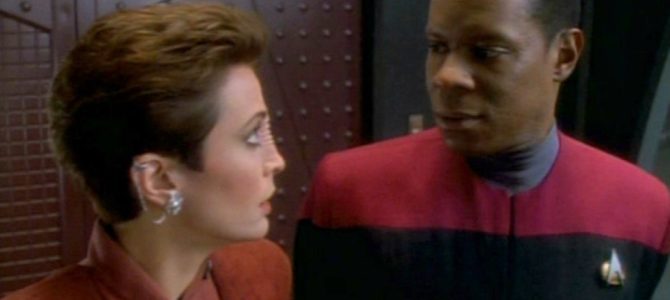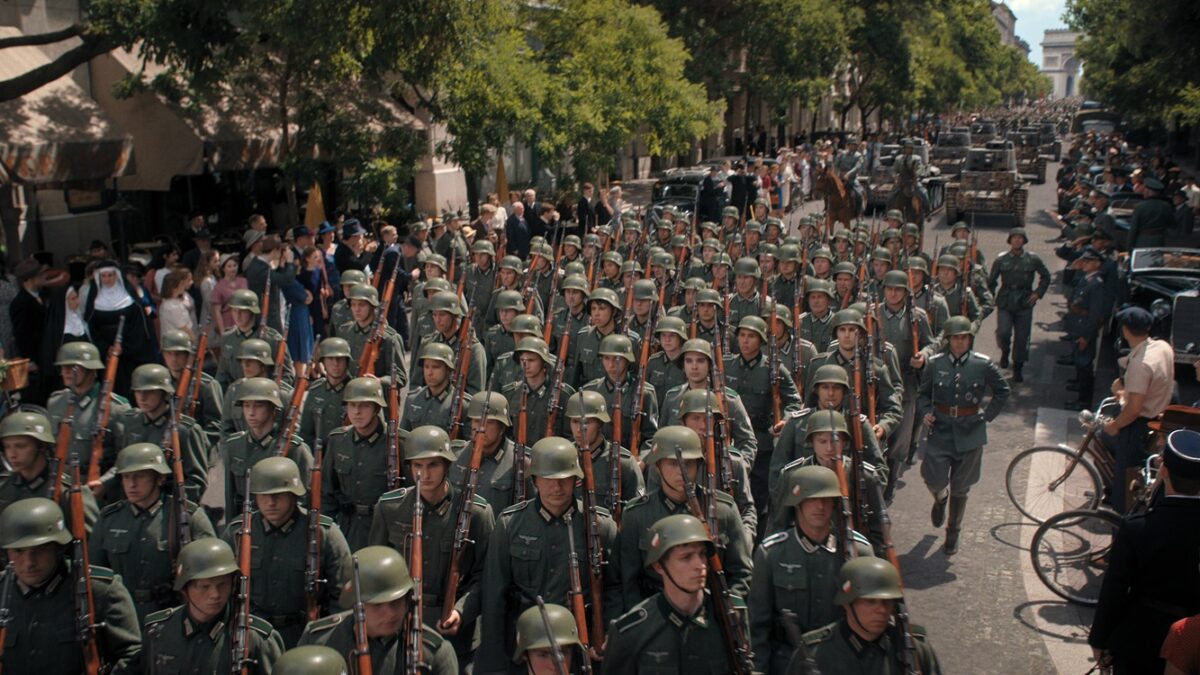
Spoilers ahead
When Starfleet took over Deep Space Nine, their aim was to protect the fragile peace between the Cardassian Union and the independent planet of Bajor, which it once occupied. Later, the appearance of a stable wormhole shifted the mission and the motivations of the parties. All the while, despite their protestations of neutrality, the Federation and its officers were drawn into the complicated politics of Bajor. As we see in episode 13, “The Storyteller,” this often happens whether the officers in question wish it or not.
The episode takes its name from an old Bajoran that O’Brien and Bashir encounter when the doctor answers a plea for medical assistance down on the planet. Told that the village will die without his help, Bashir is perplexed to discover a functioning town with no plague or illness circulating. They only person in poor health is a town elder (played Kay E. Kuter of “Green Acres” fame) whose title of “Sirah” makes him some sort of village leader.
Ghost Stories
What sort of leader becomes clear quickly. Bashir announces that the Sirah is dying of old age and there is little he can do to help. But the elder nonetheless rises from his bed to recite a village legend for the fourth of five nights. The tale is one of a village banding together to drive off a mysterious airborne creature, the Dal’Rok, which hates the village and wishes to destroy it. Immediately, the two Starfleet men see that this is no mere legend: the Dal’Rok is real and returns each year for five nights, seemingly repelled only by the Sirah’s recitation.
After driving it off for the fourth time that year, the Sirah collapses and dies. Before doing so, he anointed a successor, as is the custom, but instead of choosing his apprentice, Hovath (played by Lawrence Monoson) he says that the Prophets sent O’Brien to be the next Sirah. Neither O’Brien nor Hovath is pleased with the idea, but the townsfolk like it. Hovath’s first attempt to recite the tale a few days earlier was a disaster, and the Sirah had to finish the job. After that, the people lost faith in the younger man.
Their faith is the key to the story. Hovath later explains to O’Brien (after halfheartedly attempting to murder him) that unbeknownst to the people, the first Sirah created the Dal’Rok centuries ago, using a shard of a celestial orb to focus the villagers’ fears and hatred into physical form. The idea was that by forcing them to concentrate their psychic energy on repelling the creature, they would put aside their squabbles and become united. The process repeated each year and became a source of unity for the village.
Is the cycle of the Dal’Rok and the Sirah religion or mere flimflammery? In typical Star Trek fashion, the supposedly mystical origins of the Dal’Rok are proved to be the work of people, not gods. And yet, in a Deep Space Nine twist, those ancient people did summon a creature made of feelings using a religious artifact that clearly has some real power behind it. So there is a supernatural element to the story, for those who believe the Prophets to be gods, though not in the exact way it first appeared.
Water for Fighting Over
Meanwhile, on the station, Sisko is also enmeshed in Bajor’s troubles when he agrees to negotiate a land dispute between two clans. The exact nature of these clans is still unclear. The Bajorans are an advanced, spacefaring people, yet there also appears to be parts of the planet were tribes still have hereditary leaders with ancient grievances against one another. Whether these are local governmental units or sovereign entities is left uncertain, but the leaders’ titles of “tetrarch” suggest that they may be subordinate to some greater authority.
The precise dispute is one familiar from real-life history: when a border is defined by a river, what happens when the river shifts its course? The border between Mexico and the United States has had such shifts in the past, though they were typically minor in scale. One of the more important ones involved a shift in the Rio Grande’s course that added land to what became El Paso’s business district. The nations attempted to resolve this issue 1911, but it took until 1963 for them to finally agree on how the land should be divided. As the old saying goes, in the West, whiskey is for drinking; water is for fighting over.
The Bajoran situation was more drastic. The river in question had been diverted a dozen miles in one direction by the Cardassians’ occupying government, leaving a huge swathe of land to be added to one tribe’s realm. Complicating the negotiations is that one of the tribes’ leaders is a fifteen-year-old girl. The girl, Varis Sul (played by Gina Philips,) is out of her depth. She knows that compromise is necessary, but feels the need to be strong—even too strong—in defense of her tribe’s rights, if only to prove that she is tough enough to handle the job of clan leadership.
Negotiations stall, but Varis finds some new friends in Jake and Nog. Nog, especially, is entranced by her, and the two boys show their new pal all of their favorite parts of the station. Naturally, that includes getting into some mischief and, predictably, getting caught by Constable Odo. She apologizes to Sisko for her role in the caper (an attempt to steal Odo’s only possession—a bucket) but it seems clear that there was never any danger of a visiting diplomat being punished for a minor offense. Instead, Varis and Sisko talk about the challenges of leadership and the need, at times, for compromise.
Bajoran Problems, Federation Solutions
Both plotlines resolve in a predictable fashion. O’Brien accedes to the townsfolk’s demands and attempts to tell the story and drive off the Dar’Mok for another year. Unfortunately, his gift for the blarney doesn’t translate to Bajoran exorcisms. The people are unmoved and the Dal’Rok begins destroying the village. Hovath leaps into the fray and redeems himself, telling the story and uniting the villagers. O’Brien, relieved at not having to spend the rest of his life as the high priest of a Bajoran village, returns with Bashir to the station.
Sisko’s negotiation also ends amicably. Varis agrees to return control of her neighbor’s land to them but extracts the concession that her people will retain free access to the river. It is a minor modification to the situation that prevailed before the occupation, and both sides walk away happy. As O’Brien did, Sisko got the Bajorans to solve their own problems, eventually.
There is some good character development in the episode, particularly between Bashir and O’Brien. Bashir began the series as completely insufferable and is still mostly that portrayed way. Bashir begins the episode asking O’Brien—who is possibly Starfleet’s only enlisted man—to call him “Julian,” not “sir.” O’Brien does not approve, and they return to standard forms of address by the end of the episode. It looks like an interaction between an oblivious officer and a weary subordinate, but it turns out to be the first taste of a thawing of relations and, later in the series, a deep friendship between the unlikely pair.
Meanwhile, Sisko continues to emerge as a wise leader to his crew and a good father to Jake. His fatherly virtues help the orphaned Varis to see her way to a solution to her problem while developing Sisko’s character as a deliberate, thoughtful man who takes the long view. Those traits help him navigate the increasingly complicated relationships on the station, and with the planet below—something he will need to do often in seasons to come.









